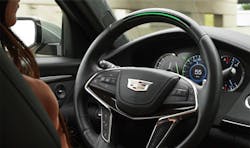Cadillac’s Semi-Autonomous “Super Cruise” Shines in Troubled Times
The hype and glamour of autonomous vehicles were dealt a body blow with the headline-stealing fatal collisions involving Tesla Motors and Uber. While many companies are aggressively pursuing the creation of autonomous and semi-autonomous vehicle platforms that can win the confidence of consumers and regulators, Tesla and Uber had been two of the more famous and pioneering players.
After the crashes, the press focus shifted from the promise and excitement of autonomous-vehicle technology to the risks and failures that were exposed by these accidents. No doubt, endless detailed analysis of what caused the failures will continue to stream out. However, other solid successes in this area should be considered to provide a balanced and even optimistic perspective of the progress, challenges, and opportunities in autonomous vehicles.
Presenting the other side, General Motor’s Cadillac is in the process of establishing an impressive track record with the deployment of Super Cruise in its 2018 model year Cadillac. With shipments starting roughly a year ago, the semi-autonomous car has performed for months in the hands of customers without a failure. This success has been achieved through a combination of transforming the OnStar connectivity platform, a robust sensor solution, and advanced mapping capabilities.
Vital to Cadillac’s success with Super Cruise is GM’s decision to introduce a driver monitoring system capable of tracking both the driver’s eyes and head movements to detect distraction. This capability was found lacking in the Tesla and Uber accidents.
In a recent report titled “Cadillac (GM) Super Cruises through Industry Crisis,” Strategy Analytics analyst, Roger Lanctot expresses his opinion that, “Above all other innovations (in the new Cadillac) the launch of Super Cruise will have the most enduring impact on the automotive industry. The new semi-autonomous driving system reflects a new attitude at General Motors where new thinking is pushing concepts into the market even as the legacy organization clings to its core connected car value propositions.”
In assessing the importance of Cadillac’s Super Cruise success for the overall automotive industry and the advancement of autonomous-vehicle technology, it’s necessary to remember GM’s size relative to other automobile manufacturers. General Motors is the fourth-largest car manufacturer in the world and the largest in North America. The weight of its technology choices and investments will have a more profound impact on the automotive industry than newcomers to the industry.
What’s the Secret Sauce to Success?
Multiple technologies, new and enhanced, are at the core of the Super Cruise platform. The driver-monitoring system was created by Seeing Machines and delivered through a partnership with Takata. Essential innovation was achieved to determine and ensure the positional accuracy of the vehicle.
According to Lanctot, “Perhaps the greatest innovation was the integration of high-definition LiDAR scans of 130,000 miles of divided highways in the U.S.” These highly detailed scans were assembled by a company called Ushr, which was spun out of GeoDigital. Ushr’s LiDAR scans enable sub-10-cm map accuracy not currently available from commercial embedded map suppliers.
Lanctot states, “The integration of a vehicle-controlling safety system with the wireless connection in the vehicle marks a critical watershed for GM.” The system is designed to receive regular weekly or monthly map updates from Ushr via the LTE connection from GM’s OnStar service. It also delivers vehicle camera images via cellular connection to the map server to determine precise road segments via the server for delivery to the vehicle. In addition, the driver can only use the Super Cruise system where the geo-fence will allow.
Previously the OnStar telematics control unit (TCU) was controlled by the OnStar team for infotainment applications or automatic crash notification. The safety engineers at the Warren Tech Center are now in control of sourcing and implementation for the TCU.
As a final major element of its semi-autonomous vehicle solution, GM implements a layered sensor suite that includes one long-range radar, two short-range radars, a monocular camera from ZF-TRW, 8-10 ultrasonic sensors, a rear-facing camera, and three rear-mounted, short-range radars. Location-enhancing technology from Trimble’s RTX service and u-blox are also applied to take into account satellite clocks, orbits, and atmospheric delay associated with GPS/GLONASS.
About the Author
Dale Ford
Industry Analyst
Dale Ford is a highly respected industry analyst with extensive experience producing award winning market research. He brings expertise in technology trends, competitive analysis, forecasting and supply/demand research of the electronics, semiconductor and electronics components industries. His focused research delivers enhanced visibility on the products, technologies, and players shaping the electronics value chain.


